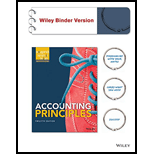
(a)
Payroll Tax Expense: The tax paid on the total earnings of employee is called payroll tax expense. Employer needs to calculate the payroll tax expense on the basis of gross earnings of the employee and deposit the total amount to respective authorities.
To define: The “employees” as per publication 15, circular E, employer’s tax guide from government.
(b)
To identify: The special rules for children, employed by their parents.
(c)
To explain: The process to obtain social security card.
(d)
To Identify: The requirement and process to report to the employer, the tips received by employee.
(e)
To identify: The place, employer needs to deposit the social security taxes withheld or contributed.
Want to see the full answer?
Check out a sample textbook solution
Chapter 11 Solutions
Accounting Principles 12E WileyPLUS with Loose-Leaf Print Companion with WileyPLUS Leanring Space Card Set
- Mangesh Analytics, Inc. sells earnings forecasts for European securities. Its credit terms are 2/15, net 40. Based on experience, 60 percent of all customers will take the discount. What is the average collection period?arrow_forwardMCQarrow_forwardMangesh Analytics, Inc. sells earnings forecasts for European securities. Its credit terms are 2/15, net 40. Based on experience, 60 percent of all customers will take the discount. What is the average collection period? HELParrow_forward
- Carter Corporation has fixed costs of $1,800,000, and variable costs are 45% of sales. What are the required sales if Carter Corporation desires a net income of $200,000?arrow_forwardMonu Enterprises received $9,000 cash from the sale of a machine that had a $13,000 book value. If the company is subject to a 25% income tax rate, the net cash flow to use in a discounted-cash-flow analysis would be:arrow_forwardWhy does stakeholder impact analysis matter? [Financial Accounting] A. Impact remains constant B. Users need identical information C. Different user needs affect reporting choices D. Shareholders alone matterarrow_forward
- I need help Briefly describing 2 analytical techniques based on the time value of money concepts. And Briefly describing 2 analytical techniques which are not based on the time value of money concepts. Along with Describing what you consider to be the top 2 advantages and 2 disadvantages of each technique and provide an example to support your top advantage of each method.arrow_forwardPlease need help with this accounting question not use aiarrow_forwardLansdowne Equipment Co. acquired machinery on January 1, 2020, for $400,000. The machinery had an original estimated useful life of 12 years and an estimated salvage value of $40,000. On January 1, 2024, Lansdowne revised the total useful life to 9 years and the salvage value to $20,000. Compute the depreciation expense for the year ending December 31, 2024, assuming Lansdowne uses straight-line depreciation.arrow_forward

 AccountingAccountingISBN:9781337272094Author:WARREN, Carl S., Reeve, James M., Duchac, Jonathan E.Publisher:Cengage Learning,
AccountingAccountingISBN:9781337272094Author:WARREN, Carl S., Reeve, James M., Duchac, Jonathan E.Publisher:Cengage Learning, Accounting Information SystemsAccountingISBN:9781337619202Author:Hall, James A.Publisher:Cengage Learning,
Accounting Information SystemsAccountingISBN:9781337619202Author:Hall, James A.Publisher:Cengage Learning, Horngren's Cost Accounting: A Managerial Emphasis...AccountingISBN:9780134475585Author:Srikant M. Datar, Madhav V. RajanPublisher:PEARSON
Horngren's Cost Accounting: A Managerial Emphasis...AccountingISBN:9780134475585Author:Srikant M. Datar, Madhav V. RajanPublisher:PEARSON Intermediate AccountingAccountingISBN:9781259722660Author:J. David Spiceland, Mark W. Nelson, Wayne M ThomasPublisher:McGraw-Hill Education
Intermediate AccountingAccountingISBN:9781259722660Author:J. David Spiceland, Mark W. Nelson, Wayne M ThomasPublisher:McGraw-Hill Education Financial and Managerial AccountingAccountingISBN:9781259726705Author:John J Wild, Ken W. Shaw, Barbara Chiappetta Fundamental Accounting PrinciplesPublisher:McGraw-Hill Education
Financial and Managerial AccountingAccountingISBN:9781259726705Author:John J Wild, Ken W. Shaw, Barbara Chiappetta Fundamental Accounting PrinciplesPublisher:McGraw-Hill Education





